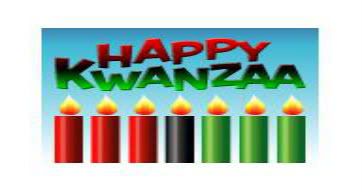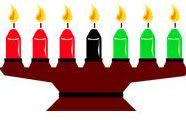
by Geri (geejay)
Kwanzaa is a Celebration of Family, Community and Culture. It is celebrated from December 26th through January 1st.
The first-fruits celebrations (Kwanzaa) are recorded in African history as far back as ancient Egypt and Nubia and appear in ancient and modern times in other classical African civilizations such as Ashantiland and Yorubaland. These celebrations are also found in ancient and modern times among societies as large as empires (the Zulu or kingdoms (Swaziland) or smaller societies and groups like the Matabele, Thonga and Lovedu, all of southeastern Africa. Kwanzaa builds on the five fundamental activities of Continental African “first fruit” celebrations: ingathering; reverence; commemoration; recommitment; and celebration. Kwanzaa, then, is:
* a time of ingathering of the people to reaffirm the bonds between them;
* a time of special reverence for the creator and creation in thanks and respect for the blessings, bountifulness and beauty of creation;
* a time for commemoration of the past in pursuit of its lessons and in honor of its models of human excellence, our ancestors;
* a time of recommitment to our highest cultural ideals in our ongoing effort to always bring forth the best of African cultural thought and practice; and
* a time for celebration of the Good, the good of life and of existence itself, the good of family, community and culture, the good of the awesome and the ordinary, in a word the good of the divine, natural and social.
This is a holiday that’s celebrated throughout the world African community. Kwanzaa brings a cultural message which speaks of what it means to be African in the fullest sense.
The theme for Kwanzaa this year is the Seven Principles: Sharing and Sustaining the World.
The are seven Symbols of Kwanzaa:
 Mazao (The Crops) symbolizing the harvest celebration
Mazao (The Crops) symbolizing the harvest celebration
Mkeka (The Mat) symbolizing the foundation on which tradition and history is built.
 Kinara (the Candle Holder) symbolizing the continental Africans, the roots.
Kinara (the Candle Holder) symbolizing the continental Africans, the roots.

Muhindi (The Corn) symbolizing the children and the future.

Mishumaa Saba (The Seven Candles) the matrix and minimum set of values for African people
 Kikombe cha Umoja (The Unity Cup) symbolizing the practice of unity.
Kikombe cha Umoja (The Unity Cup) symbolizing the practice of unity.
Zawadi (the Gifts) symbolizing the labor and love of parents and the commitments made and kept by children.
Gifts are given mainly to children. They must always include a book and a heritage symbol. The book to emphasize the African value and tradition of learning stressed since ancient Egypt. The heritage symbol is to reaffirm and reinforce the African commitment to tradition and history.

What is a Zawadi to We by Vandella Brown
Colors and decorations for Kwanzaa are black, red and green. They should include African baskets, cloth patterns, art objects and harvest symbols as well as other objects.



It is important to note Kwanzaa is a cultural holiday, not a religious one, thus available to and practiced by Africans of all religious faiths who come together based on the rich, ancient and varied common ground of their Africanness.
Kwanzaa: From Holiday to Every Day by Maitefa Angaza
The Children’s Book of Kwanzaa: A Guide to Celebrating the Holiday
by Dolores Johnson
Practicing Kwanzaa Year Round
by Gwynelle Dismukes
by Maulana Karenga






Yet again a great article! I love learning new things thanks!
Geri,
thank you for sharing your beautiful holiday traditions! But, being a major “foodie,” I would love to know what special dishes are served.
Thanks for the great article – I learned a lot.
Thank you. I’ve wondered about the roots of Kwanzaa. You’ve explained it beautifully.